A group day tour in the Brecks today. Earlier in the week, it had been forecast to be wet all day but the outlook was much improved and we were now not expecting any rain until late afternoon. We set out to make the most of it.
The meeting point for the day was at Lynford Arboretum car park. While we were getting everything packed up, we could hear a Firecrest singing in the fir trees nearby. We had a quick look to see if we could find it, but it was rather cool and breezy and the Firecrest was deep in the trees. Still it was a nice start, hearing it here. There were several Siskins in the trees here too.
Our first stop was at Santon Downham. To be assured of seeing the Lesser Spotted Woodpeckers, you need to spend several hours here, and we didn’t have that amount of time available today, with lots of other things to see. We thought it was worth chancing our luck anyway, while it remained overcast. As we walked down to the bridge, we just caught a snatch of Firecrest song from deep in the bushes, but then it went quiet. Down by the river, a Kingfisher flew off calling, circling round and disappearing into the trees the other side of the road in a flash of electric blue.
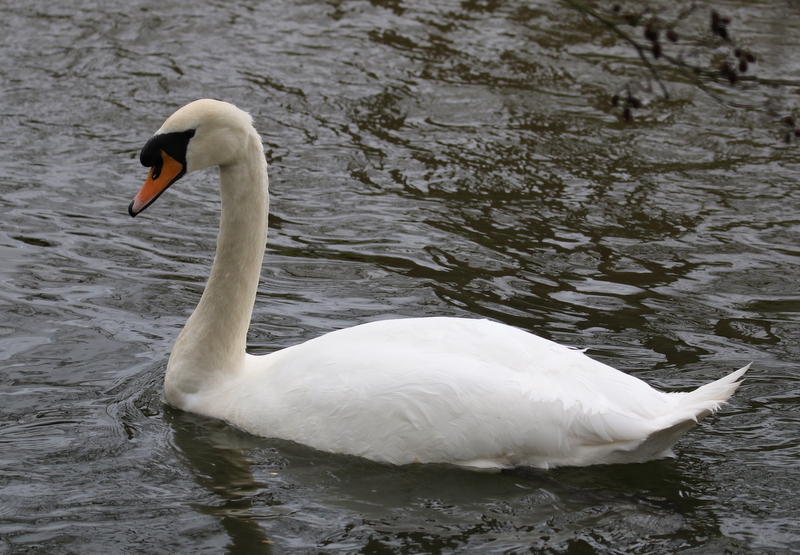 Mute Swan – a pair were busy nest building along the river
Mute Swan – a pair were busy nest building along the river
As we walked along the river bank, a couple of Bramblings flew into the bushes above one of the ditches where they like to drink and bathe. There were several pairs and small groups of Siskins and Lesser Redpolls buzzing around too, though they wouldn’t settle long enough for us to get the scope onto them at first. A Nuthatch was piping overhead in the poplars. A pair of Mute Swans were busy building a nest platform next to a fallen tree.
We hadn’t gone too far when we heard a Lesser Spotted Woodpecker calling some way ahead of us. We hurried along to where we thought the sound had come from and found several people gathered on the river bank. They had heard it too, in fact that had heard two Lesser Spotted Woodpeckers as we were on our way out, one on either side of the river, but they hadn’t been able to see them.
Eventually, after a bit of a wait, one of the Lesser Spotted Woodpeckers called again. It was on the south side of the river and a bit further back from where it had been heard previously. We walked quickly back and one or two of us just managed to get a glimpse of it deep in a tangle of branches. Unfortunately, it then disappeared again before we could get the rest of the group onto it.
While we were waiting for the Lesser Spotted Woodpecker to reappear, there were several other birds to look at. There were loads of Bramblings in the alder trees and we got a couple of them in the scope for a closer look. They should be on their way back to Scandinavia soon. More Lesser Redpolls were buzzing around the trees and eventually a couple landed and stayed still long enough for us to get them in the scope. A flock of Redwings flew ‘teezing’ through the tops. A Sparrowhawk disappeared back over the trees.
The Lesser Spotted Woodpecker called once more, but had clearly moved even further back into the trees on the other side of the river, where we stood no chance of seeing it. We waited a few more minutes to see if it would come back our way, but it had gone quiet again. It was frustrating, but we knew we had so much more to do today, so we had to head back. On our way along the river, we flushed a pair of Grey Wagtails from a tree which had fallen across the river.
Our main target for the morning was to be Goshawk. With the weather brightening up a little, we wanted to try to make the most of it, so we made our way over to a spot where we know we have a good chance of finding one at the moment. Scanning over the Forest,we could see at least eight Common Buzzards up, despite the rather cool and windy weather, which was surely a good sign.
It didn’t take too long before we were watching our first Goshawk, an adult male. It circled up out of the trees and hung in the air, then patrolled back and forth for a bit. It wasn’t displaying and its undertail coverts were not puffed out, it seemed to just be enjoying the breeze. Then it drifted off back out of view.
Shortly afterwards, another Goshawk appeared, this time a juvenile female. Through the scope, we could see its orange-tinged underparts and darker brownish upperparts. It started displaying, flying with deep, exaggerated wingbeats. This brought an immediate reaction and the next thing we knew there were three Goshawks in the air together. Presumably the same adult male we had seen earlier then proceeded to try to chase the juvenile off.
For about half an hour there was quite a bit of Goshawk activity, although they were always rather distant. At one point, the juvenile even embarked on a bit of rollercoaster display, with a series of swoops and steep climbs. Then the cloud thickened again and it went a bit quiet. Even the Common Buzzards retreated back to the trees. We had hoped to see a Goshawk a bit closer, but it felt like we might have to settle for the views we had already had.
 Goshawk – a juvenile displaying
Goshawk – a juvenile displaying
Suddenly a juvenile Goshawk appeared up out of the trees in front of us. This one was much closer and we could get a much better look at it. Again, we could see its orange-toned underparts and darker upperparts than the adults. It circled round for a while and engaged in a bit of slow flapping display, then stooped back sharply down towards the trees.
That might have been it, but at the last minute the Goshawk pulled up and landed in the top of one of the fir tree. Even better, it stayed there for several minutes, so we could get it in the scope and all get a good look at it. It is very rare to see a Goshawk perched up out in the open so this was a real treat. It looked very long legged as it tried to steady itself in the swaying branches. We could even see some of the finer plumage detail – the contrasting dark barring on the tail and the paler spotting on the upperparts. Eventually, it dropped down into the trees out of view.
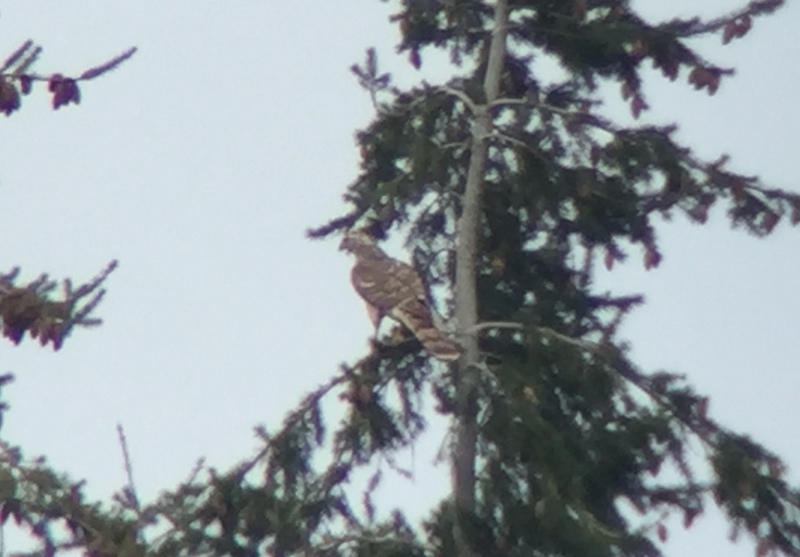 Goshawk – the juvenile landed high in a fir tree
Goshawk – the juvenile landed high in a fir tree
Having enjoyed such good views of Goshawk, we decided to head off and try our luck elsewhere. The Great Grey Shrike at Cockley Cley had not been reported yesterday, but we felt confident it was still in the area, so we made our way round there next to take a look. When we got out of the car, we could hear a Woodlark singing, but we couldn’t see it at first. It was already getting on for lunchtime, so we decided to stop for a quick bite to eat while we scanned the clearing.
A Woodlark flew across and dropped down out of view while we were eating, but thankfully, just as we were finishing up, a second Woodlark flew over from the other side, singing and what was presumably the bird we had just seen flew up too. The two of them landed in a young oak tree, where we could get them in the scope. We could see the rusty ear coverts and prominent pale supercilia, meeting at the back in a shallow ‘v’ on the back of the nape.
When they took off, one of the two Woodlarks flew back out into the middle of the clearing, but the other dropped down by the edge of the path. We walked over and found it singing from a mound of earth among the newly planted trees, its rather melancholy song being a real sound of the forest clearings in early spring.
 Woodlark – singing on the edge of one of the clearings
Woodlark – singing on the edge of one of the clearings
Another group of birders returning along the path told us that they had just seen the Great Grey Shrike, so we set off to look for that. It didn’t take long to find it, perched on a dead tree stump on the edge of a large clearing. We had a look at it through the scope, though it was rather distant at first. It flew down to the ground before reappearing back up on the fence.
We watched the Great Grey Shrike for a bit and were then distracted scanning for other birds. The next thing we knew it appeared in the top of a tall bare tree right in the middle of the clearing in front of us.
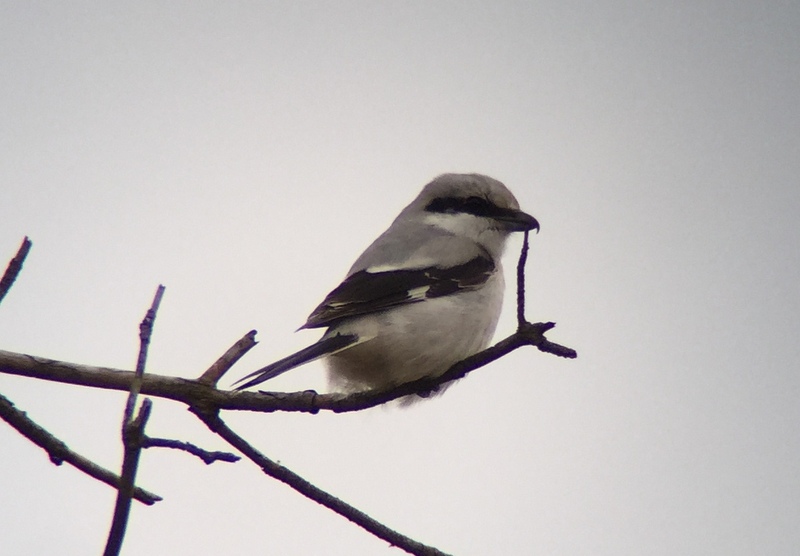 Great Grey Shrike – hunting from the trees and fence around a large clearing
Great Grey Shrike – hunting from the trees and fence around a large clearing
With our luck running at the moment, we headed round to another area where we have heard Willow Tit recently. As we walked up, we could hear it singing again and it sounded like it might be on the edge of the block of trees. Unfortunately, as we hurried up to where it was singing, it seemed to move back into the pines and then went quiet just as we started to home in on it. Still, it was great even to hear a Willow Tit, as they have become so rare now.
While we were looking for the Willow Tit, we heard a Common Crossbill singing nearby. We walked round and found a pair of Crossbills in the tops of some poplars. We got the rusty red male in the scope and could see the crossed tips to its bill. As we made our way back to the car, another tall dead tree in an open area held first a Brambling and then a smart male Yellowhammer.
We planned to finish the day at Lynford Arboretum. The clouds had started to darken a bit already, so we thought we should make our way round there to try to make the most of it. Even though it hadn’t been supposed to rain until 4pm, it started spitting as we drove over. Thankfully, that didn’t stop the Firecrest which was singing in the car park when we arrived. It was hiding in a holly tree at first, but flew up and out into the bare branches of a taller deciduous tree where we could see it, if only from below.
Unfortunately, the rain then started. There was quite a crowd gathered by the gate, looking at the feeders when we got there. There were several Hawfinches down on the ground, but they were right at the back and obscured by vegetation. They were not there for long either, as something spooked them and they flew up into the trees. There were several Bramblings which were easier to see here though, and a couple of Nuthatches feeding down on the ground. We could still hear Hawfinches calling in the trees so we walked a bit further up and looked back into the beeches, where we could see a couple of them perched in the branches.
 Hawfinch – a female, perched in the trees
Hawfinch – a female, perched in the trees
Five Hawfinches flew out and headed off towards the pines, so we walked a bit further along to see if we could catch up with them. We could still hear Hawfinches calling and at least three were chasing each other round in the tops of the trees just beyond the chicken pens. We had a look at those in the scope too, although they were a bit more distant.
There were more Hawfinches calling in the pines beyond the cultivated meadow, so we stopped there for a look. Several Redwings had been feeding down on the bare ground and had flown up into the trees nearby in the rain. We had a good look at those in the scope. Then a male Hawfinch appeared briefly with them. Unfortunately it flew before everyone could get a look at it, heading off back towards the feeders.
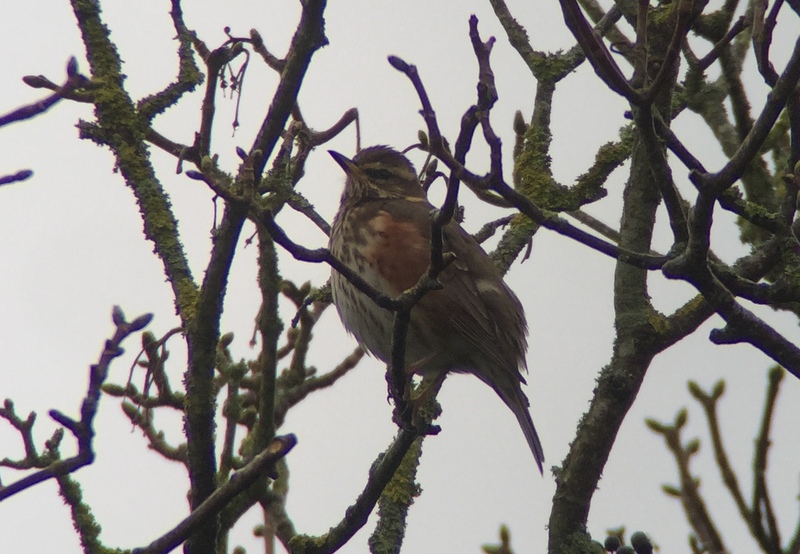 Redwing – several were still around the cultivated meadow
Redwing – several were still around the cultivated meadow
We made our way back to the feeders to see if we could get a look at a Hawfinch on the ground, and got lucky with a smart male which dropped in about half way back on the edge of the trees. It was doing its best to hide, lurking half behind one of the tree trunks at first before coming out into the open. It was also nervous and flew off into the trees, but came back down again shortly after.
This time, we all got a really good look at it, noting its huge nutcracker of a bill, black mask and bib, bright russet head and contrasting grey nape. The Hawfinch was feeding on the ground, finding seeds, probably beech mast, in the leaf litter. We could see it crunching away on whatever it was finding. Eventually it spooked again and flew up into the tops.
 Hawfinch – a smart male feeding down on the ground
Hawfinch – a smart male feeding down on the ground
Having all enjoyed great views of Hawfinch now, we decided to walk down to the bridge. As we walked down the hill, we could hear more Hawfinches calling from the trees either side of the path and even saw one or two perched up in the tops briefly.
There was some seed out on one of the pillars of the bridge, but either the food was not deemed to be up to standard or the rain was putting the birds off, as it was rather quieter here than usual. The peanut feeder was also almost empty. There were no Crossbills coming to drink down at the paddocks either, at least at the moment we were there and it was not the weather to hang around for any length of time. We did walk round and have a look at the Long-tailed Tit nest though, which is now looking just about finished, an amazing construction of moss, lichen and cobwebs.
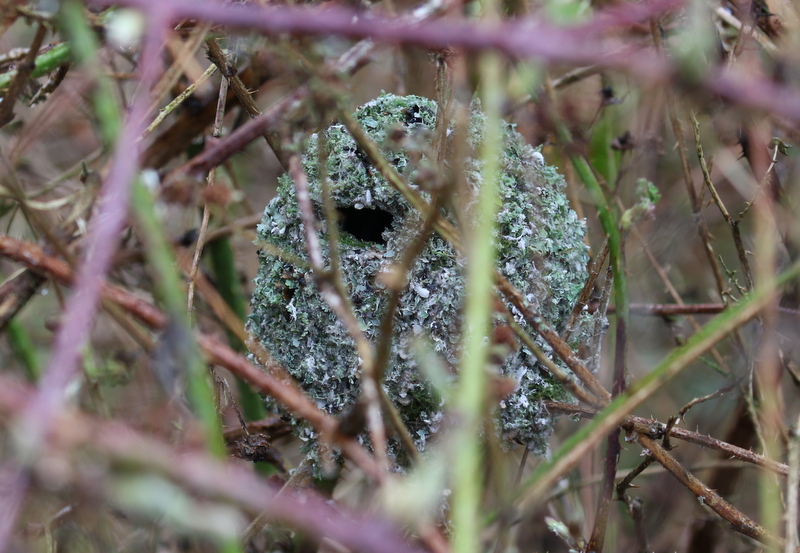 Long-tailed Tit nest – now looking just about finished
Long-tailed Tit nest – now looking just about finished
As we walked round to the lake, we could hear Mandarin calling and just managed to see two of them dropping in through the trees. They spooked as we came along the path but thankfully landed again on the grass opposite, where we could get a good look at them through the scope. The drake was looking particularly gaudy.
 Mandarin – a pair were round the lake
Mandarin – a pair were round the lake
The pair of Gadwall on the lake, in contrast, were nowhere near as brightly coloured. But we got them in the scope and admired the intricate plumage detail of the drake. They are the most under-rated of ducks, until you see them up close. We could hear a couple of Little Grebes laughing maniacally, and found one diving under an overhanging branch, where we could get it in the scope.
While we were walking round the lake, we could hear Crossbills calling over the corner of the Arboretum. Back at the bridge, we did manage to find a couple in the tops of the poplars briefly. Fortunately, we had enjoyed good views of Crossbill in the better weather earlier in the day, so we decided not to hang around. A Marsh Tit was feeding in the brash under the trees beyond the bridge and a Reed Bunting was just about the only bird coming in to the seed today.
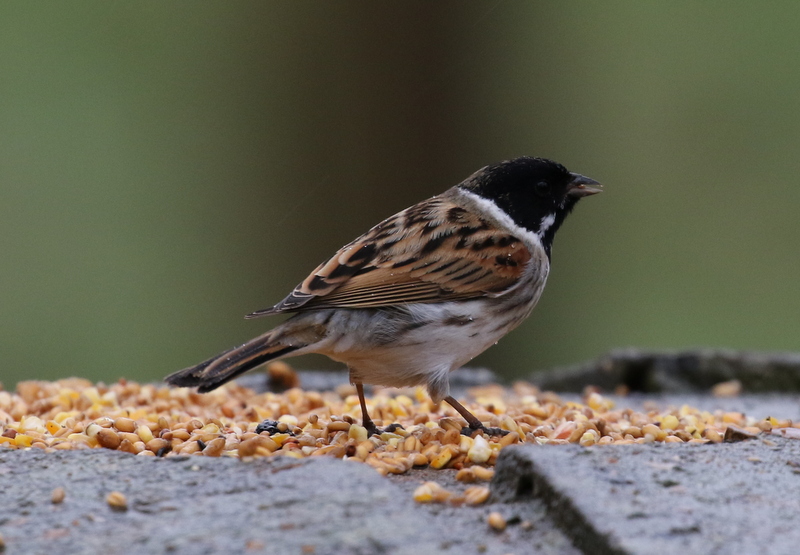 Reed Bunting – just about the only bird coming to the seed in the rain
Reed Bunting – just about the only bird coming to the seed in the rain
As we walked back to the car, there were lots of Bramblings in the trees by the chicken run. We could hear them all calling and chattering as we approached. Presumably they were gathering before going to roost. A large flock of Redwings flew out of the Arboretum and across into the pine trees, presumably also gathering for the night. Both species will be on their way soon, but perhaps it was not a night to be setting off on migration tonight, given the weather. It was time for us to head off now.
The rain coming early this afternoon was a bit of a disappointment, but it was only light and it hadn’t stopped us seeing what we wanted to see. And given the forecast from earlier in the week, we had actually been very fortunate with the weather today, and all the birds.
















